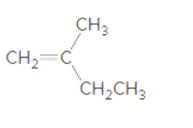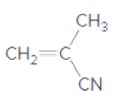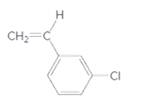
Interpretation:
The structure of polymer formed on polymerizing following compound should be determined:

Concept Introduction:
Based on type of polymers, polymerization reaction can be two types; addition polymerization and condensation polymerization. The addition polymerization occurs between monomer units with unsaturated bonds between carbon atoms. For example; polymerization of
Condensation polymerization occurs with those monomers which have some
Interpretation:
The structure of polymer formed on polymerizing following compound should be determined:

Concept Introduction:
Polymers are macromolecules which are composed of a large number of small repeating units. This repeating units are known as monomers and the process of formation of polymers from monomer units is known as polymerization.
Based on type of polymers, polymerization reaction can be two types; addition polymerization and condensation polymerization. The addition polymerization occurs between monomer units with unsaturated bonds between carbon atoms. For example; polymerization of alkene leads to formation of polyalkenes.
Condensation polymerization occurs with those monomers which have some functional groups like −OH, -COOH, -NH2 etc. These polymerizations occur with elimination of small molecules such as H2O, CO, and CO2 etc.
Interpretation:
The structure of polymer formed on polymerizing following compound should be determined:

Concept Introduction:
Polymers are macromolecules which are composed of a large number of small repeating units. This repeating units are known as monomers and the process of formation of polymers from monomer units is known as polymerization.
Based on type of polymers, polymerization reaction can be two types; addition polymerization and condensation polymerization. The addition polymerization occurs between monomer units with unsaturated bonds between carbon atoms. For example; polymerization of alkene leads to formation of polyalkenes.
Condensation polymerization occurs with those monomers which have some functional groups like −OH, -COOH, -NH2 etc. These polymerizations occur with elimination of small molecules such as H2O, CO, and CO2 etc.
Want to see the full answer?
Check out a sample textbook solution
Chapter 13 Solutions
General, Organic, & Biological Chemistry
- What is polymer? and polymerize lactic acidarrow_forwardWhat monomer is needed to form each polymer? COOEt COOEt cOOEt Et = CH,CH3 polyisobutylene (used to make basketballs) poly(ethyl acrylate) (used in latex paints)arrow_forwardWhat monomer is used to form poly(vinyl acetate), a polymer used in paints and adhesives?arrow_forward
- 1. Draw the structure of the polymer formed by the following monomer. H H H-C=C- C = Narrow_forwardWhat polymer is formed when methyl α-methylacrylate [CH 2 C(CH 3)CO2CH 3] is polymerized? This polymer is used in Lucite and Plexiglas, transparent materials that are lighter but more impact resistant than glass.arrow_forwardWhich polymer has a carboxylic acid functional group? A) Nomex B) Polyvinyl acetate C) Rubber D) Polyacrylate E) Polyethylene glycolarrow_forward
- A particularly strong and rigid polyester used for electronic parts is marketed under the trade name Glyptal. It is a polymer of terephthalic acid and glycerol. Draw a segment of the polymer and explain why it is so strong.arrow_forwardDrawing the Structure of a Polymer Formed from a Monomer What polymer is formed when CH2=CHCO2H (acrylic acid) is polymerized to form poly(acrylic acid)?arrow_forwardGeneral polymerization processes. Describe stepwise polymerization and chain polymerization.arrow_forward
 General, Organic, and Biological ChemistryChemistryISBN:9781285853918Author:H. Stephen StokerPublisher:Cengage Learning
General, Organic, and Biological ChemistryChemistryISBN:9781285853918Author:H. Stephen StokerPublisher:Cengage Learning Organic And Biological ChemistryChemistryISBN:9781305081079Author:STOKER, H. Stephen (howard Stephen)Publisher:Cengage Learning,Chemistry: Matter and ChangeChemistryISBN:9780078746376Author:Dinah Zike, Laurel Dingrando, Nicholas Hainen, Cheryl WistromPublisher:Glencoe/McGraw-Hill School Pub Co
Organic And Biological ChemistryChemistryISBN:9781305081079Author:STOKER, H. Stephen (howard Stephen)Publisher:Cengage Learning,Chemistry: Matter and ChangeChemistryISBN:9780078746376Author:Dinah Zike, Laurel Dingrando, Nicholas Hainen, Cheryl WistromPublisher:Glencoe/McGraw-Hill School Pub Co ChemistryChemistryISBN:9781305957404Author:Steven S. Zumdahl, Susan A. Zumdahl, Donald J. DeCostePublisher:Cengage Learning
ChemistryChemistryISBN:9781305957404Author:Steven S. Zumdahl, Susan A. Zumdahl, Donald J. DeCostePublisher:Cengage Learning Chemistry: An Atoms First ApproachChemistryISBN:9781305079243Author:Steven S. Zumdahl, Susan A. ZumdahlPublisher:Cengage Learning
Chemistry: An Atoms First ApproachChemistryISBN:9781305079243Author:Steven S. Zumdahl, Susan A. ZumdahlPublisher:Cengage Learning





